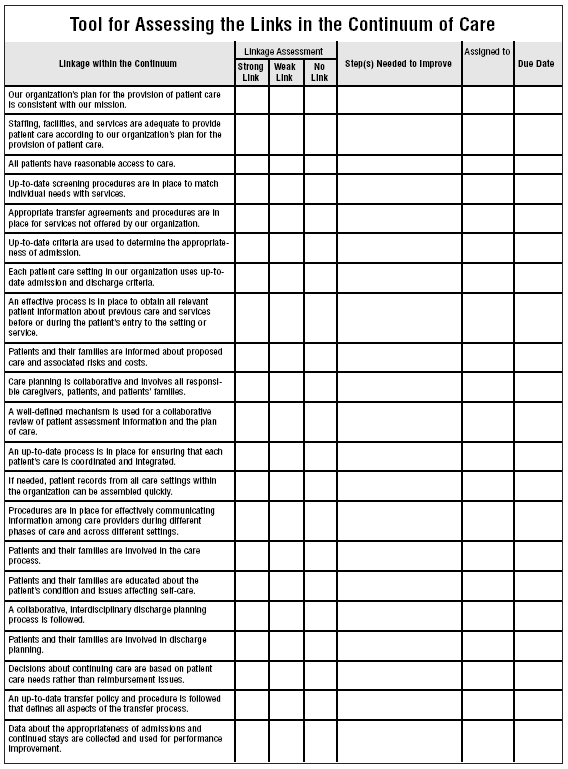The Quality-Cost Connection: Are your care continuum linkages strong or weak?
Are your care continuum linkages strong or weak?
Tool designed to assess and improve linkages
By Patrice Spath, RHIT
Brown-Spath & Associates
Forest Grove, OR
Health care delivery has grown more sophisticated and complex in response to changing patient needs and emerging technologies.
Regardless of length and breadth of the patient care continuum, the goal should be to deliver seamless, patient-centered care. However, with few exceptions, that goal has not been realized.
That concern was substantiated in the 2001 report Crossing the Quality Chasm: A New Health System for the 21st Century, published by the Institute of Medicine. According to the report’s authors, the health care delivery system is highly fragmented and, for the most part, lacks even rudimentary information-sharing capabilities.
Case managers, nurses, and other health care support staff serve as links between physician groups, hospitals, and other health care organizations that often operate as silos. The report’s authors maintain that safer, higher quality care will occur only through redesigned systems of care. The ideal health care system is, unfortunately, many years away. That is why it is so important today for health care professionals to be vigilant in assisting patients during the transition from one caregiver to another or from one level of care to another.
To effectively manage the patient care continuum, caregivers must control the transitions or handoffs in the process of care. These transitions may be between caregivers within the same setting, between services or departments within the same setting, or between caregivers in different settings.
Continuity of patient care is affected when:
- Two or more components of the heath care delivery system interact during the provision of care for a patient.
- There’s a change in the patient’s condition.
- A patient moves from service to service.
- A patient moves from setting to setting.
Nurses, case management services, and other caregivers must facilitate the effectiveness of these transitions. High-quality patient care involves more than the excellent provision of discrete health services over a defined time period. Everyone must help to ensure coordination between primary and specialty medical care, support services, and rehabilitation services, or follow-up care. Effective care coordination also should promote optimal personal autonomy, human dignity, and quality of life for patients.
Continuity of patient care is multidimensional. Interventions are needed to coordinate a great variety of relationships between patients, families, and health care services. Continuity of care has many facets, such as availability of information, availability or constancy of a caregiver, and follow-up services. The goal of effective management of continuity of care is to provide seamless patient transitions from one setting to another.
Of all facets of continuity, efficient flow of patient information is essential. Practitioners in every setting where the patient may receive care must have knowledge of or ready access to relevant facts about the patient. Health care organizations must help to make sure that complete and relevant information is available to all caregivers.
Effective information sharing must occur among the practitioners caring for a patient, whether in the same institution, between institutions, or between care settings. Information continuity depends on data being up-to-date, accurate, retrievable, understood, and used.
In transitions between settings of care, information is at risk of not being transferred, of being transferred but not read, of being read but misunderstood, or of being understood but discounted.
The tool for assessing the links in the continuum of care (see box, below) is designed to help you assess and improve the linkages within the care continuum in your organization. The elements included in this self-assessment tool are based in part on the Joint Commission on Accreditation of Healthcare Organizations standards.

An element or linkage is scored as "strong" if the element is in place and works consistently well. A linkage is scored "weak" if the element is in place but doesn’t work well or is not consistent. A linkage is scored "no link" if the element is not in place. Improvements are needed where you find weak or nonexistent linkages. The tool prompts you to document the improvement steps and then assign the improvement effort to an individual or group, along with a due date.
Ideally, this assessment is a collaborative effort among all the members of the health care team or may be assigned to a group such the hospital’s utilization management or care coordination committee. By examining patient transitions in the care continuum in your organization, everyone will have a better understanding of the capability of your systems to support consistently safe, high-quality patient care. The completed assessment will give you a snapshot of the strengths and weakness of your continuum of care linkages and provide the information you need to develop an improvement plan.
Health care delivery has grown more sophisticated and complex in response to changing patient needs and emerging technologies.
Subscribe Now for Access
You have reached your article limit for the month. We hope you found our articles both enjoyable and insightful. For information on new subscriptions, product trials, alternative billing arrangements or group and site discounts please call 800-688-2421. We look forward to having you as a long-term member of the Relias Media community.
